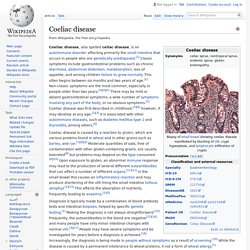

Celiac Disease Foundation. Celiac disease - sprue - PubMed Health. Celiac disease. Overview Celiac disease Your small intestine is lined with tiny hair-like projections called villi, which work to absorb vitamins, minerals and other nutrients from the food you eat.

Celiac disease damages the villi, leaving your body unable to absorb nutrients necessary for health and growth. Celiac disease, sometimes called celiac sprue or gluten-sensitive enteropathy, is an immune reaction to eating gluten, a protein found in wheat, barley and rye. Coeliac disease. Coeliac disease, also spelled celiac disease, is an autoimmune disorder affecting primarily the small intestine that occurs in people who are genetically predisposed.[1] Classic symptoms include gastrointestinal problems such as chronic diarrhoea, abdominal distention, malabsorption, loss of appetite, and among children failure to grow normally.

This often begins between six months and two years of age.[2] Non-classic symptoms are the most common, especially in people older than two years.[3][4][5] There may be mild or absent gastrointestinal symptoms, a wide number of symptoms involving any part of the body, or no obvious symptoms.[2] Coeliac disease was first described in childhood;[3][6] however, it may develop at any age.[2][3] It is associated with other autoimmune diseases, such as diabetes mellitus type 1 and thyroiditis, among others.[6] Signs and symptoms[edit] Gastrointestinal[edit]